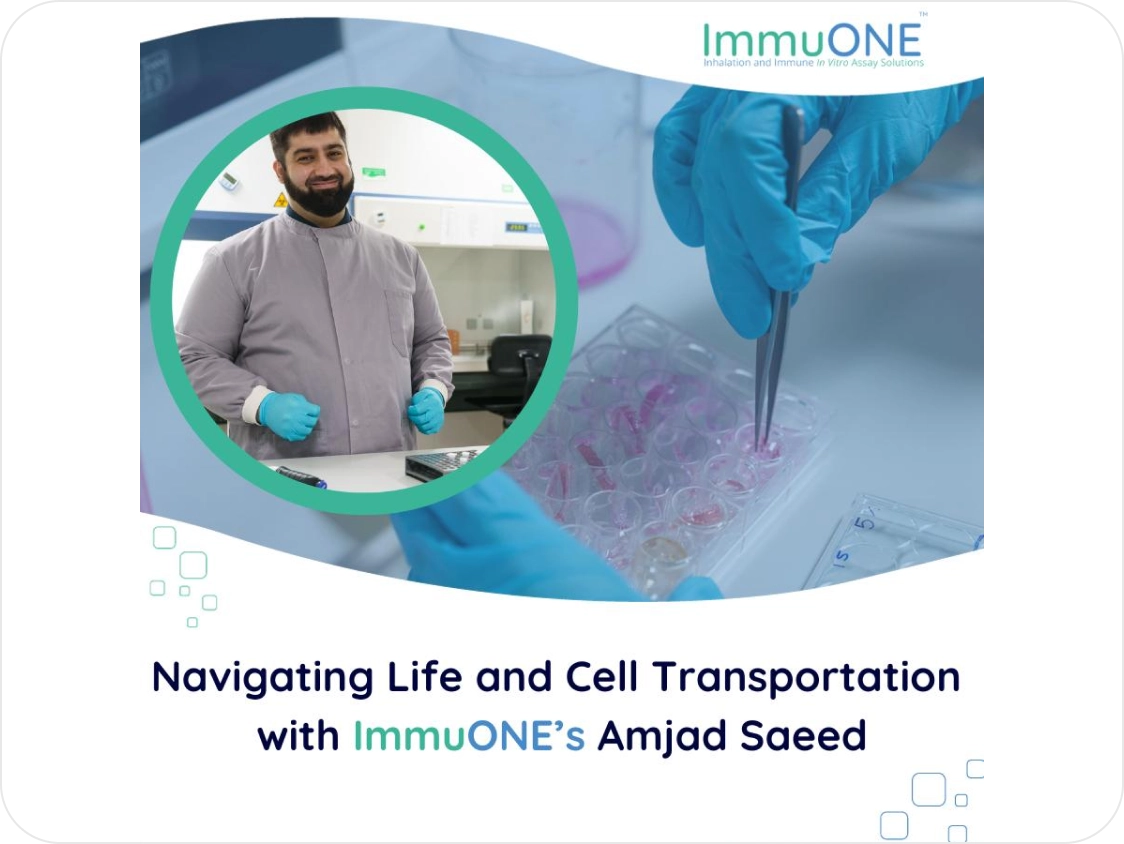Navigating Life and Cell Transportation with ImmuONE’s Amjad Saeed

Amjad Saeed is a research and development scientist with ImmuONE.
Further development of the ImmuPHAGE™ model has been the focus of Amjad’s work during his time at ImmuONE. This model is composed of alveolar macrophage-like cells which are assembled in vitro in well plates and closely mimic the form and function of their human counterparts found within the alveoli of the deep lung.
The ImmuPHAGE™ model is an exciting new tool to evaluate the safety risks of various substances such as cosmetics, tobacco, fragrances, agri-chemicals, and pharmaceuticals within the human lung. ImmuONE use ImmuPHAGE™ to highlight lower airway immune processes –such as particle clearance, inflammation, cell functionality and morphological changes – to give companies a better understanding of the immune responses within human lungs while reducing the need for animal testing, promoting progression toward more ethical and streamlined safety assessments.
Of course, innovative products such as this do not come without challenges, and it is scientists like Amjad who are prepared to step up to the mark. Now completing his PhD alongside ImmuONE, Amjad is dedicated to the development of advanced methods for the delivery of cells, such as the macrophage-like cells within the ImmuPHAGE™ model, to labs both in the UK and internationally.
We caught up with Amjad to learn about his work with ImmuONE and to find out what they are doing to address the challenges of cell transportation to an international customer base which now spans the US, Japan, and India.
Where did your journey with ImmuONE begin?
I started as a junior scientist with ImmuONE in late 2020 and my initial projects involved research into the ImmuPHAGE™ product. We had a lot of questions during the early development of ImmuPHAGE™ – how long can the cells survive in culture? How do you remove cells that adhere to the plastic of the cell culture equipment? (This makes it more difficult for the end user to detach and recover cells for further assays such as flow cytometry.) We did longevity studies, and we did a lot of characterisations to determine the functionality of the cells. During this time, we found storing ImmuPHAGE™ was a challenge, as unlike other cell products, the cells in ImmuPHAGE™ cannot be frozen for storage. This makes transportation of the cells difficult, so we had to find other ways to transport ImmuPHAGE™ to labs outside of ImmuONE. This led to me completing a master’s degree sponsored by ImmuONE in late 2021 to address this challenge. From this I have now transitioned to a PhD with the support of ImmuONE where I aim to both continue and optimise my research into the transportation of cells.
What are the problems with transportation?
Transporting cells begins with cryopreservation, a method of preserving structurally intact living cells and tissues by freezing them at extremely low temperatures. However, research has shown that cryopreserving cells which are very lipid-rich and have a high mitochondrial presence makes them more likely to die during the thawing process. This can be resolved in cell lines which still have the ability to reproduce, but not in terminally differentiated cell lines which have acquired specific functions and can no longer reproduce. ImmuPHAGE™ is both lipid- and mitochondrially-rich as well as being terminally differentiated and so cryopreservation is not a suitable transportation technique for this product – meaning we needed to look into other transportation options.
Can you explain to me how ImmuONE are addressing these challenges relating to transportation?
ImmuPHAGE™ is made up of macrophage-like cells which unfortunately are quite picky about their environment, so we have spent a lot of time exploring the use of hydrogels for the storage and transportation of ImmuPHAGE™. Hydrogels are a lattice-type structure which can be embedded with cells. Specifically, we are looking at what hydrogels will prolong cell life over an extended period so that we can transport ImmuPHAGE™ from point A to point B. To do this we have emulated the transit process internally to understand what hydrogels can best withstand transportation while also making sure the hydrogels are infused with nutrient-rich media giving the cells the supplements they need to survive. Soon our optimisations will move into chemical characterisation to see what we can further add to the hydrogels to increase survivability.
Of course, the use of hydrogels can pose challenges too as they emulate the extracellular membrane found in human tissue. This means the cells in ImmuPHAGE™ will sometimes move into the hydrogel rather than remaining on the surface of the well plates. The cells aren’t necessarily dying in the transportation process but can be lost when the hydrogel is discarded. We are therefore trying to understand how the cells might stick better to the bottom of the plastic without moving into the hydrogel while also figuring out how cells could be recoverable from the hydrogels.
What is next for you and your research into ImmuPHAGE™?
I am going to continue with these transit studies until I get the perfect result. I want the end user to be able to do anything that we can do and get the same results. ImmuPHAGE™ works extraordinarily well in our labs, but we want it to work extraordinarily well in everyone else’s lab too.
We are trying to characterise ImmuPHAGE™ even further and ideally contribute to further research. We are going to have a very well mapped out cell line that you can rely on. It is potentially a game changer.
My hope is that when I complete my PhD I will be in a position to continue within the world of R&D and hopefully take on a leading role.